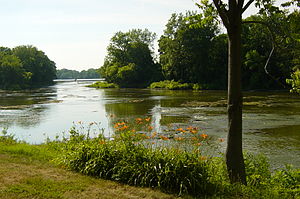| Maumee River | |
|---|---|
 The Maumee River at Grand Rapids, Ohio | |
 Map of the Maumee River watershed | |
| Location | |
| Country | United States |
| States | Indiana, Ohio |
| Cities and towns | Fort Wayne, Indiana; New Haven, Indiana; Antwerp, Ohio; Cecil, Ohio; Defiance, Ohio; Florida, Ohio; Napoleon, Ohio; Grand Rapids, Ohio; Waterville, Ohio; Maumee, Ohio; Perrysburg, Ohio; Rossford, Ohio; Toledo, Ohio; Oregon, Ohio |
| Physical characteristics | |
| Source | |
| • location | Fort Wayne by the confluence of the St. Joseph and St. Marys |
| • coordinates | 41°04′58″N 85°07′56″W / 41.0827778°N 85.1322222°W |
| • elevation | 750 ft (230 m) |
| Mouth | |
• location | Lake Erie at Toledo |
• coordinates | 41°41′58″N 83°27′36″W / 41.6994444°N 83.46°W |
• elevation | 571 ft (174 m) |
| Length | 137 miles (220 km) |
| Basin size | 6,354 sq mi (16,460 km2) |
| Discharge | |
| • average | 5,297 cu ft/s (150.0 m3/s) |
| Basin features | |
| Progression | Northeast |
The Maumee River (pronounced /mɔːˈmiː/)[1] (Shawnee: Hotaawathiipi;[2] Miami-Illinois: Taawaawa siipiiwi)[3] is a river running in the United States Midwest from northeastern Indiana into northwestern Ohio and Lake Erie. It is formed at the confluence of the St. Joseph and St. Marys rivers, where Fort Wayne, Indiana has developed, and meanders northeastwardly for 137 miles (220 km)[4] through an agricultural region of glacial moraines before flowing into the Maumee Bay of Lake Erie. The city of Toledo is located at the mouth of the Maumee. The Maumee was designated an Ohio State Scenic River on July 18, 1974. The Maumee watershed is Ohio's breadbasket; it is two-thirds farmland, mostly corn and soybeans. It is the largest watershed of any of the rivers feeding the Great Lakes,[5] and supplies five percent of Lake Erie's water.[6]
- ^ "Maumee – Definition and More from the Free Merriam-Webster Dictionary". Merriam-webster.com. Retrieved November 1, 2012.
- ^ "Shawnees Webpage". Shawnee's Reservation. 1997. Archived from the original on 2013-05-02. Retrieved 2013-04-26.
- ^ "Myaamiaatawaakani | Myaamia Dictionary". Archived from the original on 2017-08-30. Retrieved 2017-04-22.
- ^ U.S. Geological Survey. National Hydrography Dataset high-resolution flowline data. The National Map Archived 2012-03-29 at the Wayback Machine, accessed May 19, 2011
- ^ Cite error: The named reference
epawas invoked but never defined (see the help page). - ^ Cite error: The named reference
Wineswas invoked but never defined (see the help page).